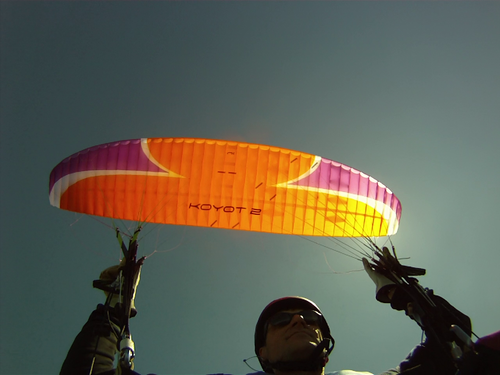Koyot 2 28 |
|||||||||||||||||||||||||||||||||||||||||||||||||||||||||||||||||||||||||||||||||||||||||||||||||||||||||||||||||||||||||


|
|||||||||||||||||||||||||||||||||||||||||||||||||||||||||||||||||||||||||||||||||||||||||||||||||||||||||||||||||||||||||
Instability rating |
|||||||||||||||||||||||||||||||||||||||||||||||||||||||||||||||||||||||||||||||||||||||||||||||||||||||||||||||||||||||||
|
|||||||||||||||||||||||||||||||||||||||||||||||||||||||||||||||||||||||||||||||||||||||||||||||||||||||||||||||||||||||||
Glider characteristics |
|||||||||||||||||||||||||||||||||||||||||||||||||||||||||||||||||||||||||||||||||||||||||||||||||||||||||||||||||||||||||
|
Launch preparations: average
launch characteristics: balanced, climbs constantly, no guidance necessary, good feedback during inflation, little braking required, slows before zenith, control check simple, low takeoff speed
asymmetric collapse: moderate dynamics, total course change 180-270°, (3), moderate course change rate, moderate forward pitching 45-60°, (2), high height loss 40-49 m, (3), moderate sink velocity 15-19 m/s, (2), G-Force < 2,5 G, (1)
Frontal collapse: low pitch backwards <30°, moderate pitch forwards 30-45°, moderate dynamics, course change 90-180°, (3), variable recovery behaviour, at times immediate, at times delayed, automatic recovery, (3), usually symmetric recovery, horseshoe, wingtips at rear, delayed return to normal airspeed, delayed reinflation of wingtips, very high height loss >50 m, (4), low sink velocity 10-14 m/s, (1)
Spiral dives: rapid sink velocity increase, Low G-Force 3,0- 3,5 G, (1), Sink velocity after 720° <18 m/s, (3), Moderate maximum sink velocity < 18 m/s, (2), no increase of sink velocity on brake release (1), Course change 180-360° after spiral exit, (2), moderate height loss during recovery 30-60 m, (2)
B-Stall: normal force required, moderate pitch backwards 15-30°, moderate pitch forwards 15-30°, stable sink phase, no tendency to deform, immediate return to normal airspeed, 6-8 m/s, height loss on recovery < 20 m
big ears: simple initiation, stable flight phase, immediate automatic recovery, Vsink unaccelerated 2,5-3 m/s, Vsink accelerated 3-3,5 m/s, Vunaccelerated 3-5 km/h less than trimspeed, Vaccelerated 3-5 km/h faster than trimspeed |
|||||||||||||||||||||||||||||||||||||||||||||||||||||||||||||||||||||||||||||||||||||||||||||||||||||||||||||||||||||||||
Notes |
|||||||||||||||||||||||||||||||||||||||||||||||||||||||||||||||||||||||||||||||||||||||||||||||||||||||||||||||||||||||||
|
Launch Characteristic: our of the five LTF-A gliders demonstrated good school suitability in terms of launching the glider. For this segment it is particularly important that gliders do not tend to overshoot, as this quickly over-c hallenges new pilots. Niviuk Koyot 2, Icaro Cyber TE, Nova Susi and Ozone Mojo 4 are all excellent here. Their canopies climb steadily with comfortable pressure on the A-risers and slow automatically as the reach the zenith. Only moderate brake appliance is necessary to stabilise them. Asymmetric Collapse: Koyot 2 change course to a greater degree and suffer more height loss than the other test gliders. Front Collapse: Niviuks Koyot 2 reacts as expected for an LTF-A glider for front collapses up to 40%. For a maximum possible leading edge collapse the canopy tends to remain in a stable closed position for several seconds. Air intakes are not filled, and the canopy then horseshoes to the rear with long recovery delays. Spiral Dive: Relatively dynamic transition from entry to spiral, with rapid increase in sink rate and G-force. Exit relatively simple. Glider collapses on outer ear at 17 m/s which resists further acceleration. B-Stall: The LTF-A glider Koyot 2, displayed good behaviour in B-stalls. No deformation tendencies, stable sink phase with good sink rates and no recovery or deep stall problems on exiting. Big Ears: Performing big ears on all of the tested gliders was unproblematic. |
|||||||||||||||||||||||||||||||||||||||||||||||||||||||||||||||||||||||||||||||||||||||||||||||||||||||||||||||||||||||||
Rating |
|||||||||||||||||||||||||||||||||||||||||||||||||||||||||||||||||||||||||||||||||||||||||||||||||||||||||||||||||||||||||
|
Safety class 4 This class of paraglider reacts demandingly to one or more of the following manoeuvres: frontal collapse, asymmetric collapse or spiral dive.Demandingly means that the above manoeuvres result in marked dynamic reactions from the glider and/or large height losses. Advanced piloting skills which need to be regularly practised, together with good personal reaction times are required to safely fly this class of gliders. Basic recovery techniques for ending a manoeuvre are not sufficient to maintain control, reduce height loss to a minimum and prevent subsequent critical reactions. Pilots should be able to recognise the onset of the above manoeuvres and be able to prevent or minimise their effects through immediate and precise pilot inputs. Additional experience such as regular ground handling and SIV training is required to safely fly gliders of this class. Special training or pilot skills which exceed standard training may be required for the safe performance of emergency descent techniques. Gliders of this Safety Class are not suitable for beginners, irregular flyers or low-airtime pilots. |
|||||||||||||||||||||||||||||||||||||||||||||||||||||||||||||||||||||||||||||||||||||||||||||||||||||||||||||||||||||||||

